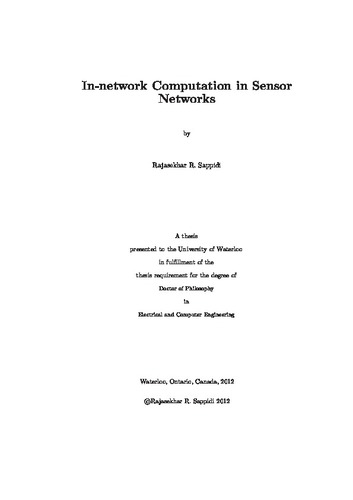| dc.description.abstract | Sensor networks are an important emerging class of networks that have many
applications. A sink in these networks acts as a bridge between the sensor nodes
and the end-user (which may be automated and/or part of the sink). Typically,
convergecast is performed in which all the data collected by the sensors is
relayed to the sink, which in turn presents the relevant information to the
end-user. Interestingly, some applications require the sink to relay just a
function of the data collected by the sensors. For instance, in a fire alarm
system, the sinks needs to monitor the maximum of the temperature readings of
all the sensors. For these applications, instead of performing convergecast, we
can let the intermediate nodes process the data they receive, to significantly
reduce the volume of traffic transmitted and increase the rate at which
the data is collected and processed at the sink: this is known as in-network
computation.
Most of the current literature on this novel technique focuses on asymptotic
results for large networks and for very elementary functions. In this
dissertation, we study a new class of functions for which we want to compute
explicit solutions for networks of practical size.
We consider the applications where the sink is interested in the first
M statistical moments of the data collected at a certain time.
The k-th statistical moment is
defined as the expectation of the k-th power of the data. The M=1 case represents the
elementary functions like MAX, MIN, MEAN, etc. that are commonly considered in
the literature. For this class of functions, we are interested in explicitly
computing the maximum achievable throughput including routing, scheduling and
queue management for any given network when in-network computation is allowed.
Flow models have been routinely used to solve optimal joint routing and scheduling
problems when there is no in-network computation and they are typically
tractable for relatively large networks. However, deriving such models is not
obvious when in-network computation is allowed. Considering a single rate wireless network
and the physical model of interference, we develop a discrete-time model for
the real-time network operation and perform two transformations to obtain a flow
model that keeps the essence of in-network computation. This model gives an
upper bound on the maximum achievable throughput. To show the tightness of that
upper bound, we derive a numerical lower bound by computing a feasible solution
to the discrete-time model. This lower bound turns out to be
close to the upper bound proving that the flow model is an excellent
approximation to the discrete-time model.
We then adapt the flow model to a
wired multi-rate network with asynchronous transmissions on links with different
capacities. To compute the lower bound for wired networks, we propose a
heuristic strategy involving the generation of multiple trees and effective
queue management that achieves a throughput close to the one computed by the
flow model. This cross validates the tightness of the upper bound and the
goodness of our heuristic strategy. Finally, we provide several engineering
insights on what in-network computation can achieve in both types of networks. | en |

